Mold in Dishwasher
Ever open your dishwasher and see discoloration around the seal? After doing a clean cycle, does your dishwasher have a musty odor? If so, you may have mold growth in your dishwasher.
Your dishwasher provides a great environment for mold to grow. Dark, damp, warm with lots of organic material in the form of food is what mold thrives on to grow.
In this article, we will look deeper into what causes mold in your dishwasher and how to remove and prevent mold growth inside and outside of your dishwasher.
Worried About Mold in Your Dishwasher? Get a Free Inspection!
Dishwashers are common places for mold to grow, often going unnoticed until it becomes a health hazard. Don’t let it spread! Contact Mold Busters for a free virtual mold inspection. Our experts will provide a comprehensive assessment and plan to tackle any mold issues, ensuring your home remains safe. Act now to protect your family!
Contents
- What causes mold growth in your dishwasher?
- Signs of mold inside your dishwasher
- What does mold in your dishwasher look like?
- What types of molds can grow in your dishwasher?
- Is mold inside your dishwasher dangerous?
- How do you prevent mold inside your dishwasher?
- How do you remove mold inside your dishwasher?
- Frequently Asked Questions
What causes mold growth in your dishwasher?
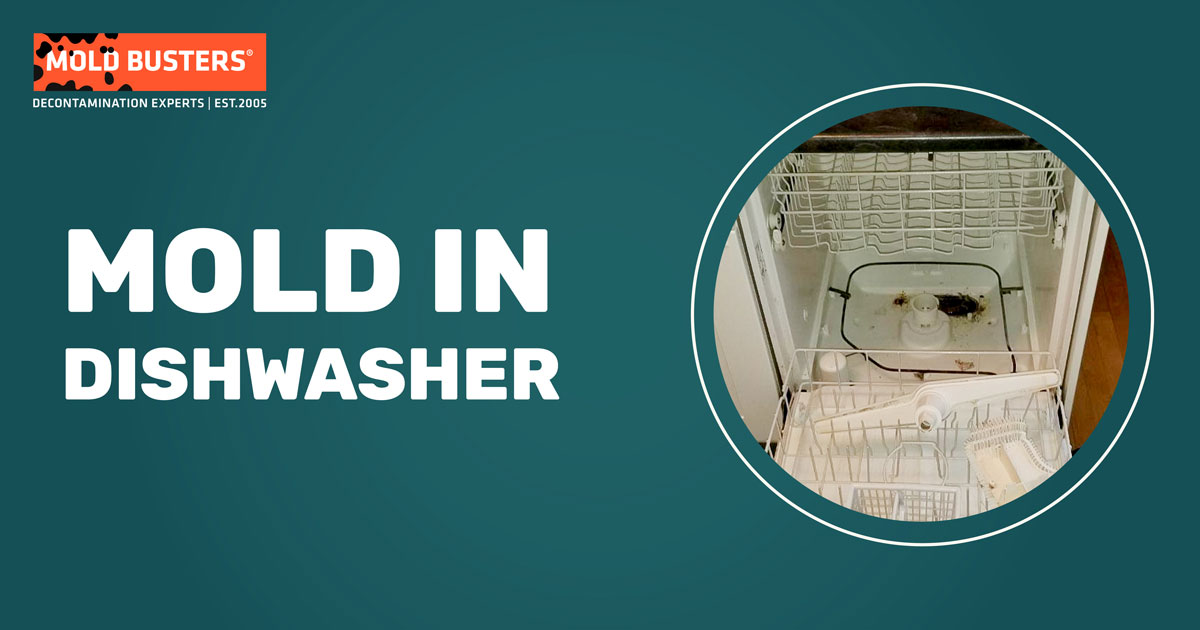
Over time, food particles get stuck in various seals, racks, and crevices inside the dishwasher. This food is a perfect nutrient source for mold to grow. Coupled with water, heat, and a dark environment, mold will grow quickly inside the dishwasher. It’s often tucked away around the door seals where you cannot see it growing, so it goes unnoticed until it becomes a bigger issue.
The mold growth could be any number of mold spores present in the air, so some growth may be hazardous to your health, while others are not. Mold Busters can visit your home and take samples of the mold to be tested to identify the type of mold growing in your dishwasher.
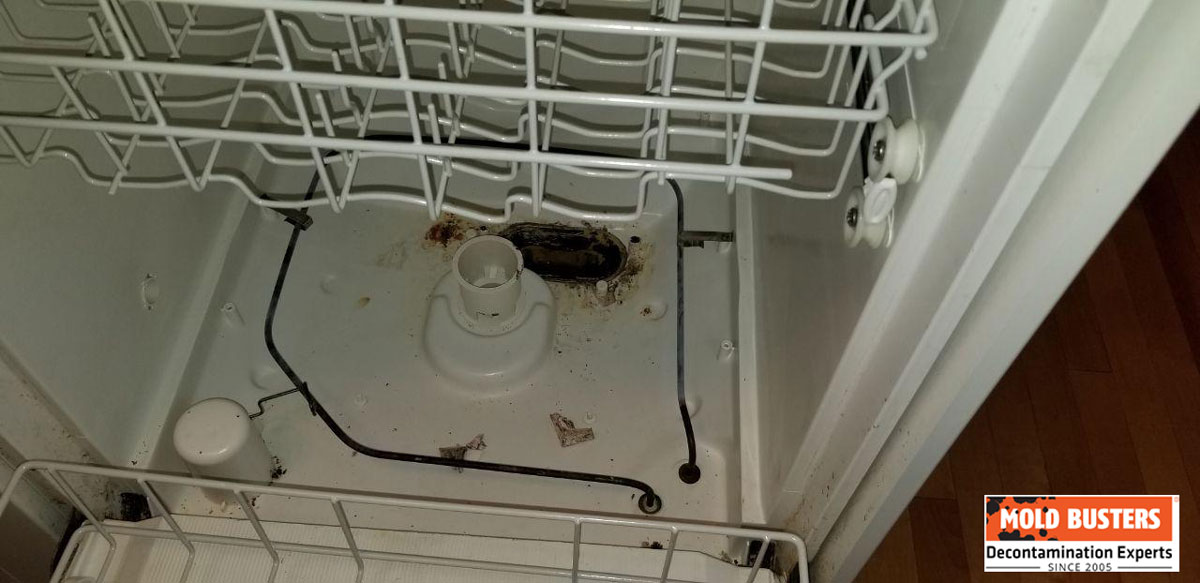
If your dishwasher is leaking, the mold can be growing outside your unit. Therefore, cleaning the dishwasher inside is only part of the solution. If you have a leak and you notice discoloration or odors in your cabinets or outside your dishwasher, you may have a leak causing mold growth around the dishwasher instead of inside it. If you think you have an exterior mold colony growing, contact a professional inspectors at Mold Busters right away to have a complete inspection done.
Signs of mold inside your dishwasher
There are many signs to indicate that you have a mold issue inside your dishwasher. Some are obvious, while others can be hidden and hard to locate. We will give you a few more common places to check to see if you have a mold issue inside your dishwasher.
Dishwasher smell
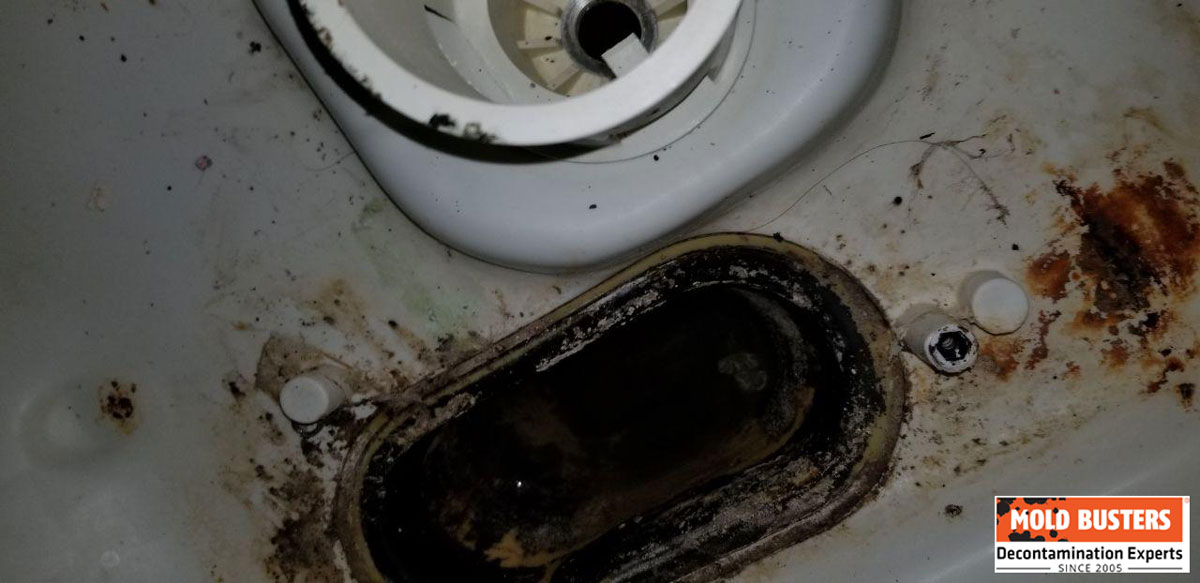
Have you ever opened your dishwasher and got a musty or foul smell coming from inside? This is certainly a sign that you could have mold growing inside your dishwasher. It could be just a build-up of food leftover from the previous wash cycle, but it could also be mold growing somewhere in your machine.
Mold on dishes and dishwasher rack
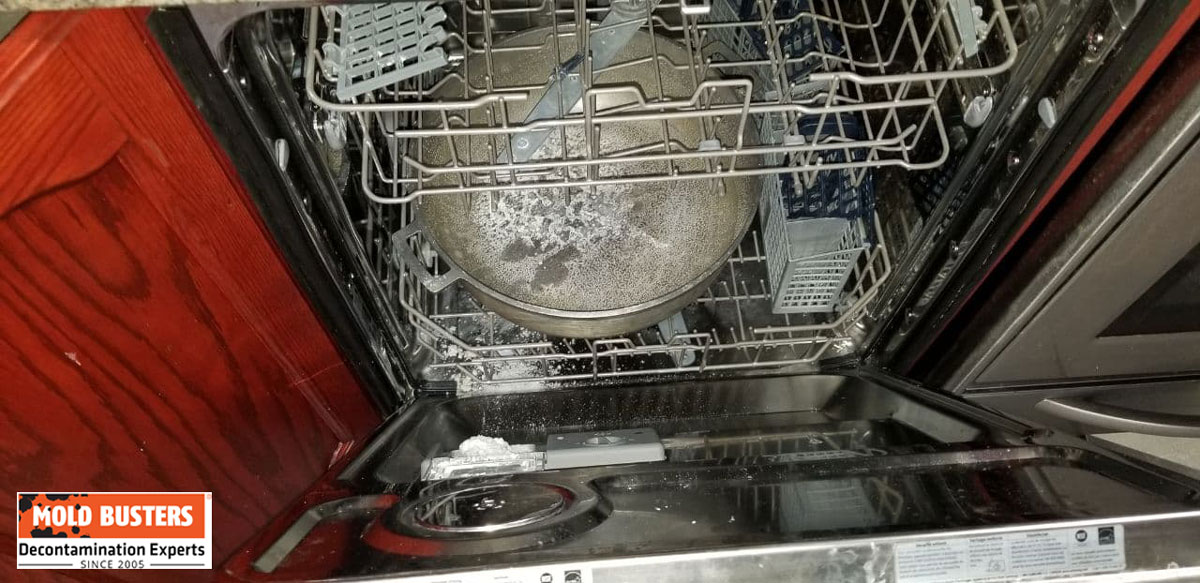
If there is a large enough colony of mold growing inside your dishwasher, and you don’t run the machine every day, you could find that the mold will start growing on your dishes. This happens because there is a build-up of food on the dishes that will feed the mold spores and cause them to grow. The food is a great source of nutrients for the mold to thrive. This is also true for the dishwasher rack. The same rules apply since the dishes sit on the rack and food particles get lodged on the racks causing the mold to start to colonize on them.
If you need professional help, consider our virtual inspection service.
Mold in drain hose
A drain hose is also a great place for mold to start growing. It’s a warm, damp, dark environment with lots of food sources holding up in various places. The mold will attach itself to the food particles throughout your drain hose and start growing. It may get washed away when the drain cycle is run; however, the water never gets through the entire hose; therefore, mold will seek these drier but damp areas to form.
Mold in vent
Similar actions take place in the vent of your dishwasher. The steam venting out while the dishes are drying causes an ideal place for the mold to congregate and grow. Warm and dark is the preferred environment for mold, and the vent provides this.
Mold behind dishwasher
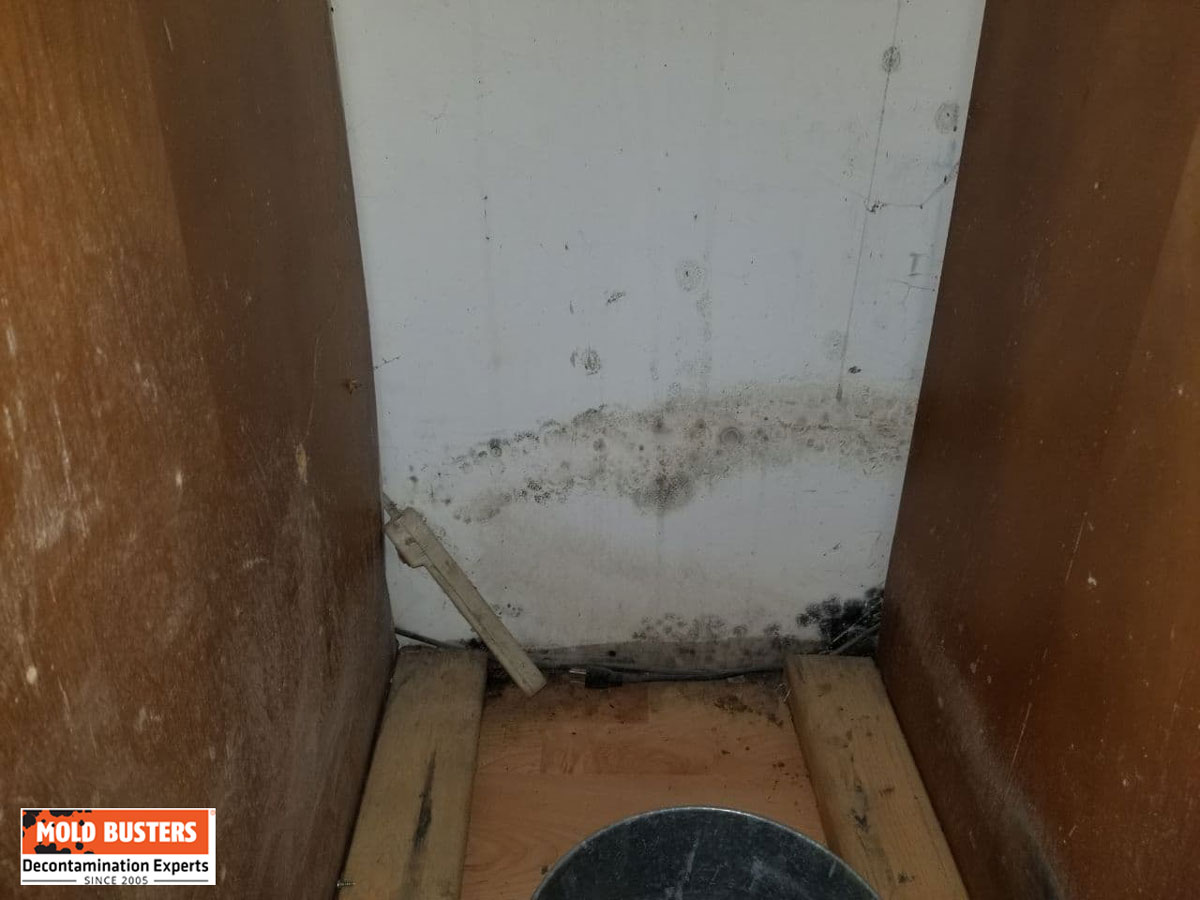
If you have the telltale musty smell and looked inside your dishwasher to the best of your ability, you may have a leak outside your dishwasher. Removal of the machine may be necessary to find the growing colony. It could be growing on the wall, cabinets, on or under the floor covering. All of these are great places for mold to grow near your dishwasher. If you are experiencing any of the above, contact Mold Busters for a complete and intensive inspection to ensure your home and family are healthy and safe. Our teams in Montreal and Ottawa are ready to assist you.
What does mold in your dishwasher look like?
Mold inside or behind your dishwasher can look like several different things. It could look like rust color spots on the interior of the tub. It could look like a build-up of dirt and food around the door’s seals of the dishwasher or inside the supply, drain, or vent of the dishwasher. Often, it will appear black or grey in color, but as with most mold growing, it can take on different appearances. The rule of thumb is, if it looks different or odd, contact Mold Busters for an inspection to know exactly what it is.
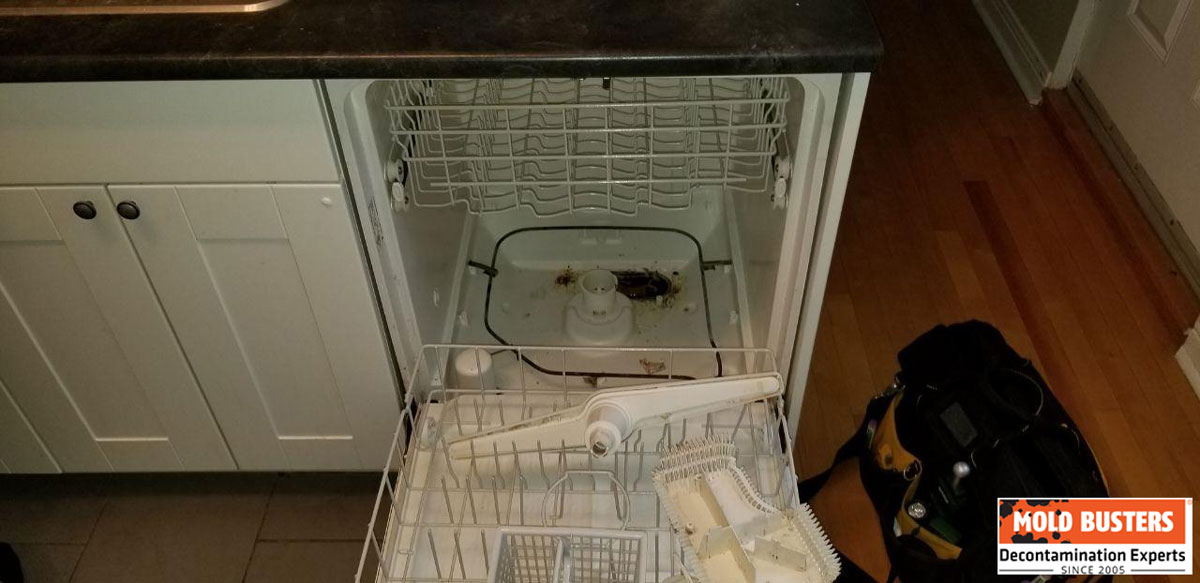
The same can be said for mold growing outside or behind your dishwasher. It can take the appearance of black, green, or dark brown spots, or it can be a full-blown colony growing behind the dishwasher for an extended period that you did not realize was there. At that point, Mold Busters need to be called and have the mold professionally remediated to create a safe home for you and your family.
What types of molds can grow in your dishwasher?
Your dishwasher is a great environment for mold to grow. It is dark, with warm and damp airspace. Because there is always food coming from your dishes inside, it is a perfect place for mold to live.
Various types of mold can grow inside your dishwasher, and we will touch briefly on some of these. If you see any mold growing inside or outside your dishwasher, contact Mold Busters for a complete inspection to provide a professional and accurate report of what is growing inside.
- Black mold in dishwasher – The first type of mold that could be growing inside your dishwasher is black mold, and it can take on the form of rotting food, mildew, or black spots around the drain, vent, or door seals.
- Orange mold in dishwasher – The second type of mold that is common in dishwasher environments is orange mold. This could look like rust on your dishwasher parts or even on your dishes, and this could be wrongly identified as rust, so have a Mold Busters professionals come to your home and make sure you know what is growing inside the dishwasher.
- Pink mold – Another type of mold common to the very high humidity environment of a dishwasher is pink mold. This mold will take on the form of light or bright pink foam or “marshmallow” type growths around the dishwasher. They can take the color of light cotton candy to something as bright as a popular stomach medicine we all know.
Is mold inside your dishwasher dangerous?
As with all mold and fungal types, some molds are dangerous while others are harmless and sometimes helpful to humans. The main thing to remember about molds inside your dishwasher is that you cannot tell if the mold is safe or dangerous. So, treat all mold types as if they are not good for you. Have a Mold Busters professional inspect and test the molds that are growing, so you are certain of what type of mold it is.
How do you prevent mold inside your dishwasher?
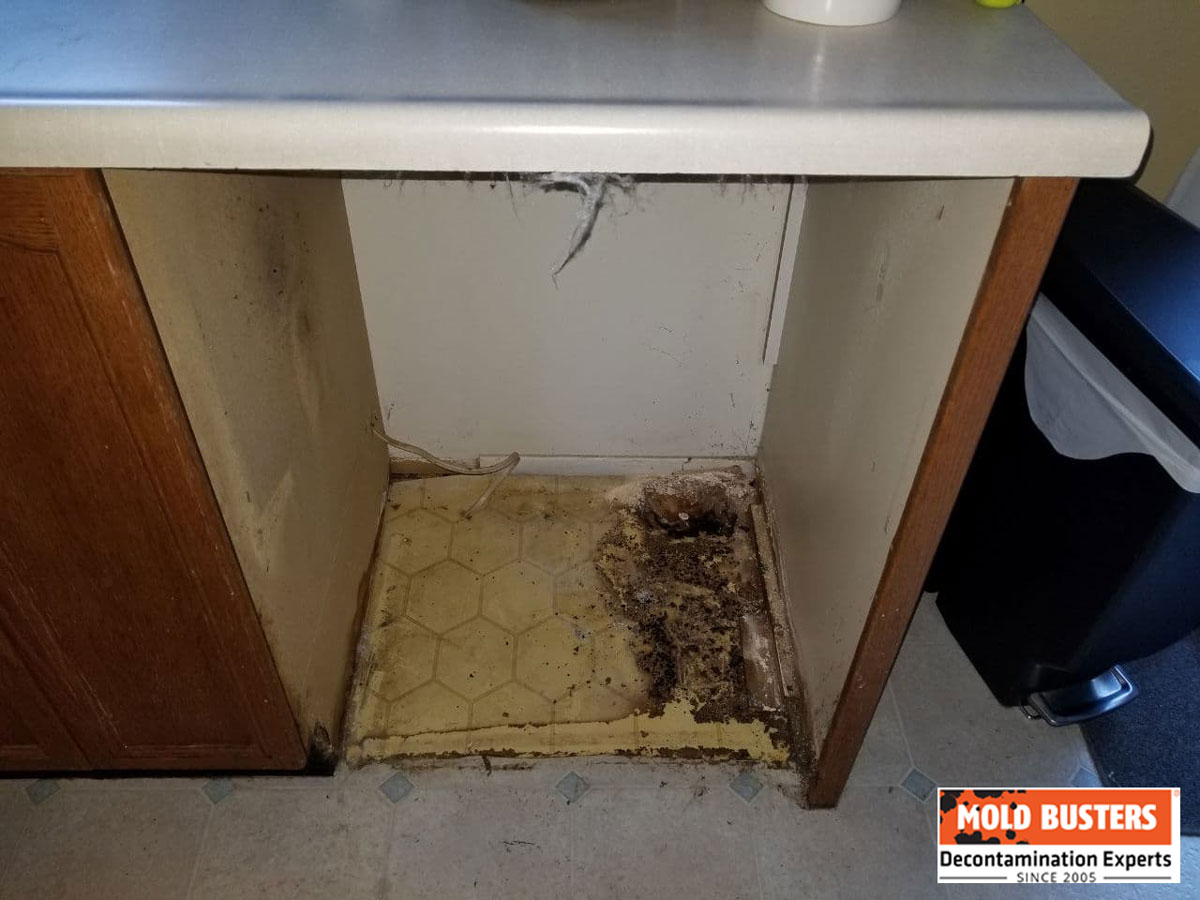
The best way to prevent mold from growing inside your dishwasher is to keep it clean and dry after each use. When you unload the machine of your dishes, look around inside to see if there is any build-up of food anywhere. If there is, remove it and wipe down the areas where it was. Also, take a paper towel and wipe around the door’s seal to dry it and clean it of any food particles that may have been lodged in there. The final step is to open the door a little to let the moisture escape and the unit to dry out inside. These measures will go a long way to keep your dishwasher clean and healthy.
How do you remove mold inside your dishwasher?
To remove a small amount of mold growing inside your dishwasher, you can try using a combination of vinegar and baking soda. Sprinkle the baking soda inside your dishwasher and put a cup of vinegar on the top rack of your dishwasher and run a cycle. If this does not clean the mold from the inside, contact a Mold Busters to inspect and remediate the mold from your dishwasher.
In Conclusion
Mold can be dangerous no matter where it is growing. Your dishwasher is your line of defense against bacteria growing on your dishes and making your family sick. This can be compounded by having mold growing inside the machine and distributing on your dishes, cookware, and utensils. If you ingest this mold growth, it could make you and your family sick. Therefore, keeping your dishwasher clean and functioning properly is very important to your health.
Frequently Asked Questions
How do I get a moldy or musty smell out of my dishwasher?
To remove this common smell from your dishwasher, you must first figure out what is causing the smell. Is it food particle build-up? Could it be water trapped somewhere inside the machine? Could it be mold? To answer these questions, you can quickly inspect your dishwasher to determine what is causing it. If it is just a food build-up, you can remove the excess food particles and run the vinegar and baking soda wash cycle, and you should be fine. If it is mold in a place, this clean cycle will not get to you may need professional help from Mold Busters to get rid of this smell.
Can mold inside a dishwasher make you sick?
Any type of mold could make you sick from contact with it. The best rule of thumb to take when it comes to mold is always to treat it like it’s a dangerous type of mold, and that way, you handle it correctly and carefully, even if it is harmless.
Can a dishwasher clean mold off my dishes?
Technically, yes. The dishwasher can clean mold off your dishes. However, the real issue is why the mold is on your dishes in the first place. Was it because they were sitting in the sink for a long time? Or was it because there was a mold colony inside your dishwasher dispersing mold onto your dishes while they were being cleaned? This is the issue you would need to know to have a proper diagnosis.

Get Special Gift: Industry-Standard Mold Removal Guidelines
Download the industry-standard guidelines that Mold Busters use in their own mold removal services, including news, tips and special offers:
"*" indicates required fields
Published: November 3, 2021 Updated: May 31, 2024

Written by:
Steven Adams
AMRT, WRT, ASD
Mold Busters
Fact checked by:
Michael Golubev
CEO
Mold Busters
